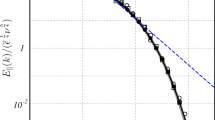Abstract
The root cause of different oscillatory behavior of turbulent stress anisotropy under rapid rotation of initially axisymmetric turbulence is theoretically investigated. For this, based on the velocity spectral tensor of axisymmetric turbulence, the rapid part of the pressure-strain is determined and the equation of the turbulent stress anisotropy is solved for initial conditions generated by axisymmetric expansion and contraction of isotropic turbulence. As is well known, the damping of turbulent stress anisotropy under rapid rotation is observed for both initial conditions, and this feature is attributed to the linear rapid rotation effect on turbulence. On the other hand, the oscillatory development of turbulent stress anisotropy can be seen conspicuously only for the initial turbulence generated by axisymmetric expansion. This selective oscillatory feature is found to be strongly related to the total strain that is applied to the isotropic turbulence to generate the initial axisymmetric turbulence. And, through an asymptotic approach, it is also found that the material frame-indifference principle of two-dimensional turbulence is the underlying physics in this different oscillatory behavior.
Similar content being viewed by others
References
W. C. Reynolds, Effects of rotation on homogeneous turbulence, Proceedings of the 10th Australian Fluid Mechanics Conference, Australia. (1989).
N. N. Mansour, T.-H. Shih, and W. C. Reynolds, The effects of rotation on initially anisotropic homogeneous flows, Phys. Fluids A 3 (1991) 2421–2425.
W. C. Reynolds and S. C. Kassinos, One-point modelling of rapidly deformed homogeneous turbulence, Proc. R. Soc. Lond. A 451 (1995) 87–104.
C. Cambon, L. Jacquin, and J. L. Lubrano, Toward a new Reynolds stress model for rotating turbulent flows, Phys. Fluids A 4 (1992) 812–824.
S. C. Kassinos and W. C. Reynolds, A structure-based model for the rapid distortion of homogeneous turbulence, Report TF-61, Thermosciences Division, Department of Mechanical Engineering, Stanford University, USA. (1994).
C. Cambon and L. Jacquin, Spectral approach to non-isotropic turbulence subjected to rotation, J. Fluid Mech. 202 (1989) 295–317.
J. P. Bertoglio, Homogeneous Turbulent Field within a Rotating Frame, AIAA Journal 20 (1982) 1175–1181.
M. J. Lee, Distortion of homogeneous turbulence by axisymmetric strain and dilatation, Phys. Fluids A 1 (1989) 1541–1557.
Author information
Authors and Affiliations
Corresponding author
Additional information
This paper was recommended for publication in revised form by Associate Editor Yang Na
Ju-Yeop Park received a B.S. degree in Mechanical Engineering from Yonsei University in 1991. He then went on to receive his M.S. and Ph.D. degrees from Korea Advanced Institute of Science and Technology in 1993 and 1999, respectively. Dr. Park is currently a Senior Researcher at Korea Institute of Nuclear Safety in Daejeon, Korea. Dr. Park’s research interests are in the area of nuclear safety analysis, rotating turbulence, and computational fluid dynamics.
Rights and permissions
About this article
Cite this article
Park, J.Y., Chung, M.K. Investigation on the turbulent stress anisotropy of axisymmetric turbulence under rapid rotation. J Mech Sci Technol 23, 768–774 (2009). https://doi.org/10.1007/s12206-008-1212-0
Received:
Revised:
Accepted:
Published:
Issue Date:
DOI: https://doi.org/10.1007/s12206-008-1212-0




